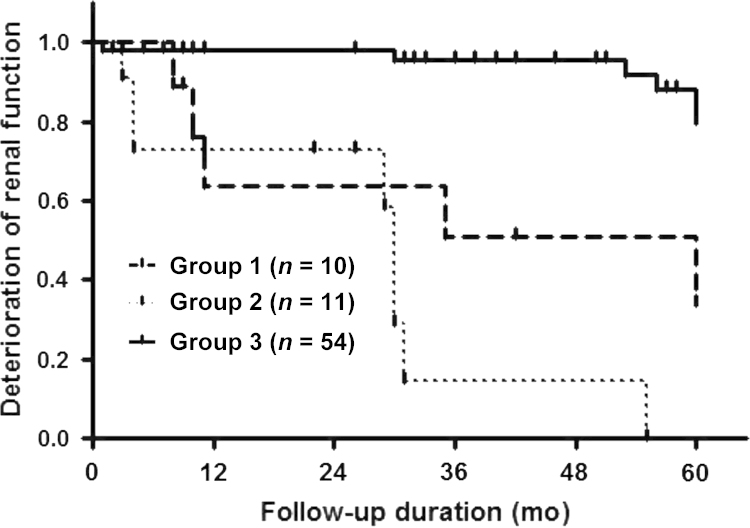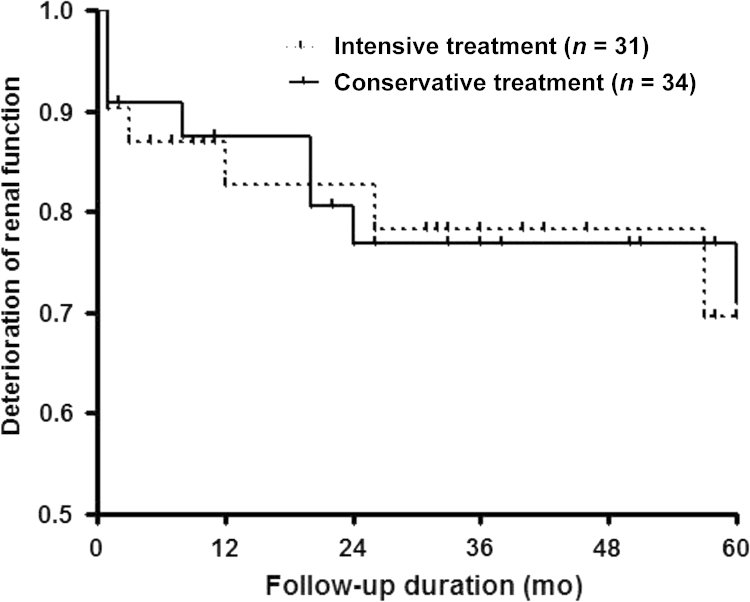1. Zhou J., Chen X., Xie Y., Li J., Yamanaka N., Tong X.. A differential diagnostic model of diabetic nephropathy and non-diabetic renal diseases.
Nephrol Dial Transplant 23:2008;1940–1945.


2. Diabetes Care.
3. Gross J.L.. de Azevedo MJ, Silveiro SP, Canani LH, Caramori ML, Zelmanovitz T: Diabetic nephropathy: diagnosis, prevention, and treatment.
Diabetes Care 28:2005;164–176.


4. Jin D.C.. Current status of dialysis therapy in Korea.
Korean J Intern Med 26:2011;123–131.



5. Gambara V., Mecca G., Remuzzi G., Bertani T.. Heterogeneous nature of renal lesions in type II diabetes.
J Am Soc Nephrol 3:1993;1458–1466.


6. Ruggenenti P., Gambara V., Perna A., Bertani T., Remuzzi G.. The nephropathy of non-insulin-dependent diabetes: predictors of outcome relative to diverse patterns of renal injury.
J Am Soc Nephrol 9:1998;2336–2343.


7. Suzuki Y., Ueno M., Hayashi H., Nishi S., Satou H., Karasawa R., Inn H., Suzuki S., Maruyama Y., Arakawa M.. A light microscopic study of glomerulosclerosis in Japanese patients with noninsulin-dependent diabetes mellitus: the relationship between clinical and histological features.
Clin Nephrol 42:1994;155–162.

8. Wong T.Y., Choi P.C., Szeto C.C., To K.F., Tang N.L., Chan A.W., Li P.K., Lai F.M.. Renal outcome in type 2 diabetic patients with or without coexisting nondiabetic nephropathies.
Diabetes Care 25:2002;900–905.


9. Kim B.S., Chang Y.K., Song H.C., Lee S.Y., Jang S.N., Kim H.W., Shin Y.S., Choi Y.J., Jin D.C., Kim Y.S.. The clinical differentiations between diabetic nephropathy and non-diabetic renal disease in type 2 diabetic patients. Korean J Nephrol 28:2009;588–594.
10. Chong Y.B., Keng T.C., Tan L.P., Ng K.P., Kong W.Y., Wong C.M., Cheah P.L., Looi L.M., Tan S.Y.. Clinical predictors of non-diabetic renal disease and role of renal biopsy in diabetic patients with renal involvement: a single centre review.
Ren Fail 34:2012;323–328.


11. Soni S.S., Gowrishankar S., Kishan A.G., Raman A.. Non diabetic renal disease in type 2 diabetes mellitus.
Nephrology (Carlton) 11:2006;533–537.


12. Bi H., Chen N., Ling G., Yuan S., Huang G., Liu R.. Nondiabetic renal disease in type 2 diabetic patients: a review of our experience in 220 cases.
Ren Fail 33:2011;26–30.


13. KDOQI Clinical Practice Guidelines and Clinical Practice Recommendations for Diabetes and Chronic Kidney Disease. Am J Kidney Dis 49:2007;S12–154.
14. Parving H.H., Hommel E., Mathiesen E., Skott P., Edsberg B., Bahnsen M., Lauritzen M., Hougaard P., Lauritzen E.. Prevalence of microalbuminuria, arterial hypertension, retinopathy and neuropathy in patients with insulin dependent diabetes. Br Med J (Clin Res Ed). 296:1988. p. 156–160.
15. Lee E.Y., Chung C.H., Choi S.O.. Non-diabetic renal disease in patients with non-insulin dependent diabetes mellitus.
Yonsei Med J 40:1999;321–326.


16. Tone A., Shikata K., Matsuda M., Usui H., Okada S., Ogawa D., Wada J., Makino H.. Clinical features of non-diabetic renal diseases in patients with type 2 diabetes.
Diabetes Res Clin Pract 69:2005;237–242.


17. Monga G., Mazzucco G., di Belgiojoso G.B., Confalonieri R., Sacchi G., Bertani T.. Pattern of double glomerulopathies: a clinicopathologic study of superimposed glomerulonephritis on diabetic glomerulosclerosis.
Mod Pathol 2:1989;407–414.

18. Hayashi H., Karasawa R., Inn H., Saitou T., Ueno M., Nishi S., Suzuki Y., Ogino S., Maruyama Y., Kouda Y., Arakawa M.. An electron microscopic study of glomeruli in Japanese patients with non-insulin dependent diabetes mellitus.
Kidney Int 41:1992;749–757.


19. Lin Y.L., Peng S.J., Ferng S.H., Tzen C.Y., Yang C.S.. Clinical indicators which necessitate renal biopsy in type 2 diabetes mellitus patients with renal disease.
Int J Clin Pract 63:2009;1167–1176.


20. Mak S.K., Gwi E., Chan K.W., Wong P.N., Lo K.Y., Lee K.F., Wong A.K.. Clinical predictors of non-diabetic renal disease in patients with non-insulin dependent diabetes mellitus.
Nephrol Dial Transplant 12:1997;2588–2591.


21. Zajjari Y., Benyahia M., Montasser Ibrahim D., Kassouati J., Maoujoud O., El Guendouz F., Oualim Z.. Non-diabetic renal disease in type II diabetes mellitus patients in Mohammed V Military Hospital, Rabat, Morocco.
East Mediterr Health J 18:2012 620–623. [Article in French].


22. Ghani A.A., Al Waheeb S., Al Sahow A., Hussain N.. Renal biopsy in patients with type 2 diabetes mellitus: indications and nature of the lesions.
Ann Saudi Med 29:2009;450–453.



23. Olsen S., Mogensen C.E.. How often is NIDDM complicated with non-diabetic renal disease? An analysis of renal biopsies and the literature.
Diabetologia 39:1996;1638–1645.







 PDF Links
PDF Links PubReader
PubReader Full text via DOI
Full text via DOI Download Citation
Download Citation Print
Print
















